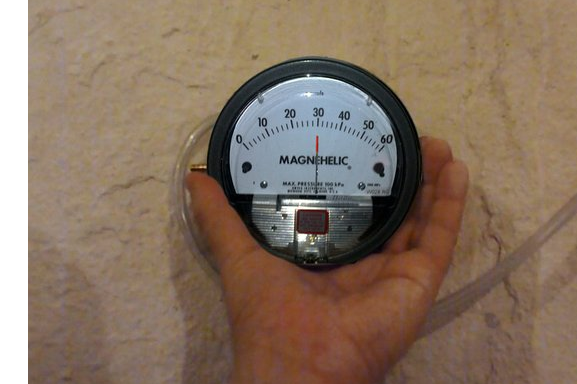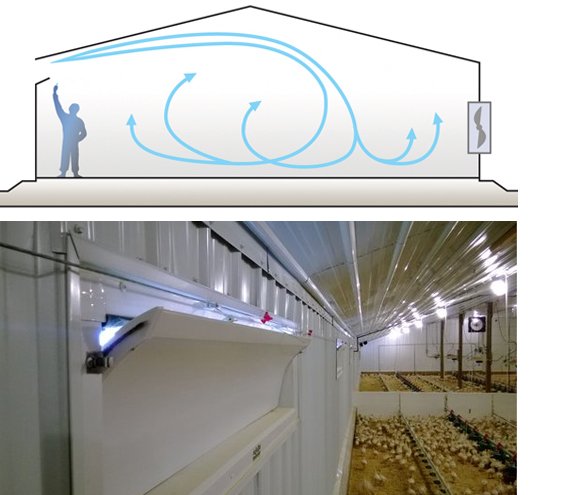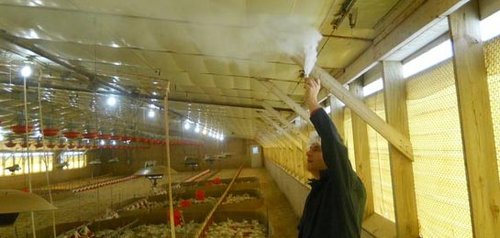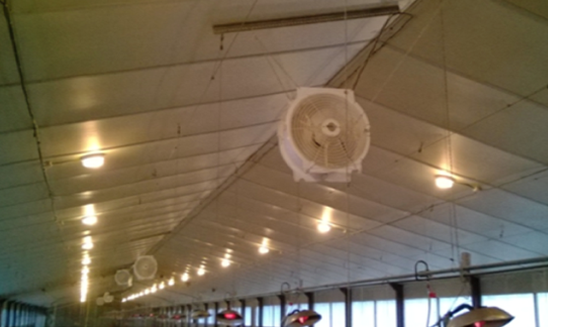Minimum ventilation
The goal of correct minimum ventilation is to
- Promote uniform temperatures throughout the house
- Reduce fuel use and improve litter quality
- Mix warm air in the barn with incoming cold air to reduce humidity
Optimally, the air should be spread at least half way across the house. Good air flow can be accomplished by controlling the inlet opening and through the use of stir fans.
Minimum ventilation is used during cold weather and for brooder houses.
Setting up minimum ventilation
1) Tight testing
Follow the instructions below
- Close curtains and/or inlets
- Make sure all holes are closed around walls, end doors, etc.
- Turn minimum fans on. This would equal as close to 1.0 cfm per square foot (20 m3/h/m²) as possible.
- Static pressure (SP) should be .15-.20” SP (35-50 Pa) if house is tight.


2) Open inlets
- Now begin to open inlets. Keep in mind the minimum inlet opening should be approximately 2-3” (5-8 cm) wide (anything smaller will choke the inlet and not allow air to ‘throw’ correctly). Cold air entering the desired inlets should travel along the ceiling and mix with the warm air in the center of the barn.
- Approximate total inlet opening should be near 80-85 sq inch per 1,000 cfm (500-550 cm² per 1700 m3/h fan capacity)
- Open inlets until the SP is .10-.12” (25-30 Pa) for 50’ (15 m) or wider and .08-.10” (20-25 Pa) for less than 50’ (15 m)wide. This will be the minimum number of inlets to be used with the minimum fans.
Attic inlets may be used for minimum ventilation. See manufacturer specifications for ventilation rate requirements and spacing.
3) Smoke the house
A smoker is a good way to easily see how air is flowing in the barn. The video to the right demonstrates an example of good air flow using a smoker. If you see air is being thrown into the center and mixed with warm air, the inlets are correctly adjusted and air speed is good.


4) Timer settings
- Minimum timer setting will be enough to maintain humidity to less than 60% as well as the target gas level for carbon dioxide (< 2,500 ppm), carbon monoxide (< 20 ppm), and ammonia (< 25 ppm). Typically, one half minute per week of age on a five minute cycle timer is sufficient. However, depending on your set-up, this may not be enough air volume to control the humidity and gas levels. If this is the case, then increase the cycle time in 15 second intervals until air quality parameters improve.
- Additional thermostat fans will be set 0.5°C (1°F ) above the minimum fan settings to come on as the house warms. For houses with auto inlets, the inlets will open automatically based on increased SP with more fans. For houses with manual inlets, they will have to be opened manually or the curtain lowered manually to reduce SP as more fans come on thermostat.
- Additional timer fans may need to be added as birds get older. This should be done only when the minimum fans have reached 7-8 minutes on.
- Additional inlets may need to be opened to compensate for increased pressure with more fans.
- Circulation fans will aid in utilizing the heat build-up at the ceiling of the house, in addition to throwing incoming air into the center.
Examples of minimum ventilation set up by age
Remember that every barn is different in its ventilation needs. Below is an example of how you can set up minimum ventilation by age. Look at bird behavior to check if they are too hot (panting) or too cold (huddling and sitting), and adjust as needed. If temperatures exceed the highest degree listed, turn on tunnel ventilation (if available). Learn more about tunnel ventilation set up
| Age | Target temperature ˚F | Fans (quantity x size) | Timer on (˚F ) | Timer off (˚F ) |
|---|---|---|---|---|
| 0-2 weeks | 74 | 2 x 36" | 76 | 74 |
| 0-2 weeks | 74 | 3 x 36" | 78 | 76 |
| 2-12 weeks | 68 | 2 x 48" | 70 | 68 |
| 2-12 weeks | 68 | 3 x 48" | 72 | 70 |
| 12 weeks and older | 62 | 2 x 48" | 64 | 62 |
| 12 weeks and older | 62 | 3 x 48" | 66 | 64 |
